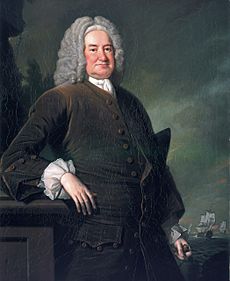Kingdom of Sardinia (1700–1720) facts for kids
The island of Sardinia was part of the Spanish Empire from 1700 to 1720. During this time, two powerful families, the Habsburgs and the Bourbons, fought over who should rule Spain and its lands, including Sardinia.
When King Charles II of Spain died in 1700 without children, he left his throne to Philip, Duke of Anjou, who was a Bourbon. But the Holy Roman Emperor Leopold I, a Habsburg, also believed he should be the king. This disagreement led to a big war called the War of the Spanish Succession.
Sardinia's leaders first supported Philip V. However, in 1708, with help from the British navy, the island was taken over by the Habsburgs. After the war ended, several peace agreements were signed, like the Treaty of Utrecht (1713). These treaties gave Sardinia and other Spanish lands to the Habsburg emperor, Charles VI.
But this didn't last long! Spain took Sardinia back in 1717. Then, in 1720, another agreement called the Treaty of The Hague was signed. This treaty officially gave Sardinia to the House of Savoy, a powerful family from Italy. From then on, Sardinia was no longer part of the Spanish Empire.
Contents
Sardinia's Changing Rulers (1700-1720)
Under Bourbon Rule (1700–1708)
When Philip V became king, the Spanish leaders in Sardinia were loyal to him. But some people on the island wanted the Habsburgs to rule instead.
In 1706, two brothers, the Conde de Cifuentes and the Conde de Montesanto, led a revolt to support the Habsburg prince, Archduke Charles. A strong supporter of Philip V, Vicente Bacallar, put down this revolt.
How Sardinia Became Habsburg
In 1708, a large British navy fleet arrived in Sardinia. They brought Austrian and Spanish soldiers who supported Archduke Charles. The British ships sailed to Cagliari, the capital city.
The British commander, John Leake, sent a message to the Spanish leader in Cagliari, telling him to surrender the city to "King Charles" (Archduke Charles). The Spanish leader, the Marqués de Jamaica, tried to delay. So, the British ships started firing cannons at the city.
After a short bombardment, the Spanish leader surrendered. The city was stronger than it looked, with many cannons. The people of Cagliari were happy with the change and welcomed the British and Habsburg forces.
Under Habsburg Rule (1708–1717)
The Habsburgs Take Control
After the Habsburgs took over, the Conde de Cifuentes, who had arrived with the British fleet, became the new leader of Sardinia. His first job was to make sure the whole island was under Habsburg control and to remove anyone still loyal to the Bourbons.
In 1710, the Bourbon supporter, Vicente Bacallar, tried to get help from France and Spain to invade Sardinia and take it back. But the British navy, led by Admiral Norris, found out about the plan and stopped the invasion. The British navy was very powerful in the Mediterranean Sea, which made it hard for anyone to attack Sardinia without their permission.
How Sardinia Was Governed
In 1713, Emperor Charles VI set up a special council in Vienna to manage the lands he had gained from Spain, including Sardinia. Sardinia had its own special representative and two officials who helped run the island. These officials were often Spaniards who had supported the Habsburgs and were living in exile.
The money to pay these officials came from Sardinia itself. The island's royal income also helped pay for the military forces stationed there.
Spain Takes Sardinia Back (1717–1720)
In 1717, Spain decided to take Sardinia back. At this time, Austria, which ruled Sardinia, was busy fighting a war against the Ottoman Empire.
Spain's king, Philip V, and his main advisor, Giulio Alberoni, prepared a fleet of ships and 8,000 soldiers in Barcelona. Even though Spain had promised the Pope not to attack the Emperor while he was fighting the Ottomans, they sailed to Sardinia.
The Spanish fleet, led by the Marquis de Lede, arrived in Cagliari on July 25. Major cities like Sassari and Alghero quickly fell, and the entire island was under Spanish control by November.
The Final Exchange
Spain then tried to invade Sicily as well, but this plan failed. In the end, through the Treaty of The Hague in 1720, Spain agreed to give up its claim on Sardinia.
Later that year, in the Treaty of London, the Emperor Charles VI and Victor Amadeus II of Sardinia (the ruler of Savoy) agreed to swap islands. The Emperor gave Sicily to Savoy, and in return, Savoy received Sardinia.
On August 8, 1720, the Spanish leader in Sardinia officially handed the island over to an Austrian representative, who then gave it to the representative of Victor Amadeus. This was the final change, and Sardinia became part of the House of Savoy's kingdom.
Leaders of Sardinia (1700–1720)
Here are the main leaders, called Viceroys, who governed Sardinia during this time:
- Under Philip V (Spanish King)
- Fernando de Moncada Aragón la Cerda y Gaetano, Duke of San Juan (1699–1703)
- Francisco Ginés Ruiz de Castro, Count of Lemos (1703–1704)
- Baltasar de Zúñiga y Guzmán, Marquis of Valero (1704–1706)
- Pedro Manuel Colón de Portugal, Duke of Veragua (1706–1709)
- Under Charles III (Habsburg Emperor)
- Fernando de Silva y Meneses, Count of Cifuentes (1709–1710)
- Jorge de Heredia, Count of Fuentes (1710–1711)
- Andrés Roger de Eril, Count of Eril (1711–1713)
- Pedro Manuel, Count of Ayala (1713–1717)
- José Antonio de Rubí y Boxadors, Marquis of Rubí (1717)
- Under Philip V (Spanish King, after re-conquest)
- Jean François de Bette, Marquis of Lede (1717–1718)
- Gonzalo Chacón de Orellana (1718–1720)
Images for kids



